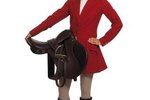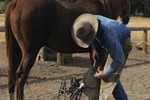
Before horseshoes, primitive horse owners -- recognizing that their horses were only as good as their hooves -- tied leather around their horses’ feet for protection. Modern-day horseshoes protect hooves, correct conformational defects and improve gaits. In some instances, a horse cannot wear shoes; in others, the owner prefers an alternative.
Barefoot
Not all horses need shoes. Genetics has a lot to do with this. Some hardy breeds, like mustangs, are known for sturdy feet; others, such as thoroughbreds, are not. How often a horse is ridden and what he does also factor. A horse who jumps regularly is more likely to need shoes than one who trots a field a few times a week. Advocates of natural barefoot trimming, or "wild horse trim," maintain that any horse can go barefoot although adjustments may be necessary. Don't make any changes without consulting both your farrier and your veterinarian.
Boots
Occasionally a horse who goes barefoot the majority of the time will need some protection, such as on a long trail ride or a rare ride on rocky ground. In such situations, many bare-hoof-horse owners turn to horse boots. A variety of these exist, but all give the hoof a temporary secure shoe surface. Typically you slip the boots over your horse's hooves, then secure them with buckles. Optional pads insert inside the boots to give a horse more comfort and support. If your horse wears traditional shoes, horse boots are handy for times when your horse may need to go barefoot temporarily or for medical conditions such as stone bruises.
Casts
Despite the name, some riders use hoof products called casts or casting to protect their horses' hooves without shoes or boots in situations like exceptionally rocky trail rides. To do so, you apply casting material around your horse’s hooves and then wet it. The material hardens as it dries. Holistic veterinarian Madalyn Ward of Texas notes that she occasionally uses casting material to support poor-quality hooves. On the upside, Dr. Ward said casting will not cause a horse's foot to get sweaty as a boot would, and it will keep dirt out. On the downside, it won't last long if you turn your horse out for long periods of time on hard ground -- about a week -- and is difficult for a novice to apply. Casts can help a typically shod horse recover from temporary hoof maladies, such as thin soles that need time to grow, by protecting his feet until he can be shod. Before applying casts for the first time, work with someone experienced in casting until you get the hang of it.
Flexible Hoof Wraps
Flexible hoof wraps are a cross between boots and casts. The wrap material does not slip on like boots do and does not contain fiberglass like most casting materials. It retains flexibility after it hardens. These wraps are sometimes referred to as polywraps due to the polyester content in the material that allows for the flexibility. Some hoof wrap kits are anchored with stainless steel plates that outline the outer part of your horse's hoof, like a shoe, but are secured with small screws. This secures the wrap for longer wearing. Like other horseshoe alternatives, you can use flexible hoof wraps on your horse permanently or temporarily while your horse’s hooves heal.
References
- The Equestrian and Horse: Horse Shoes
- Hoof Rehab: Boots and Pads: A True Breakthrough in Healing
- High Performance Hoof Care: Hoof Boots – The Sound Alternative to Conventional Horse Shoes
- Association for the Advancement of Natural Horse Care Practices: The Natural Trim
- Institute of Applied Equine Podiatry: Perfect Hoof Wear and Perfect Hoof Wear Pro Series
- ArabHorse.com: A New Model for the Holistic Approach to Performance Hoof Care!
- Fighting for the Barefoot Horse
- Madalyn Ward, DVM, Fischer, Texas
Resources
Photo Credits
-
George Doyle/Stockbyte/Getty Images
Writer Bio
Based in Central Texas, Karen S. Johnson is a marketing professional with more than 30 years' experience and specializes in business and equestrian topics. Her articles have appeared in several trade and business publications such as the Houston Chronicle. Johnson also co-authored a series of communications publications for the U.S. Agency for International Development. She holds a Bachelor of Science in speech from UT-Austin.




